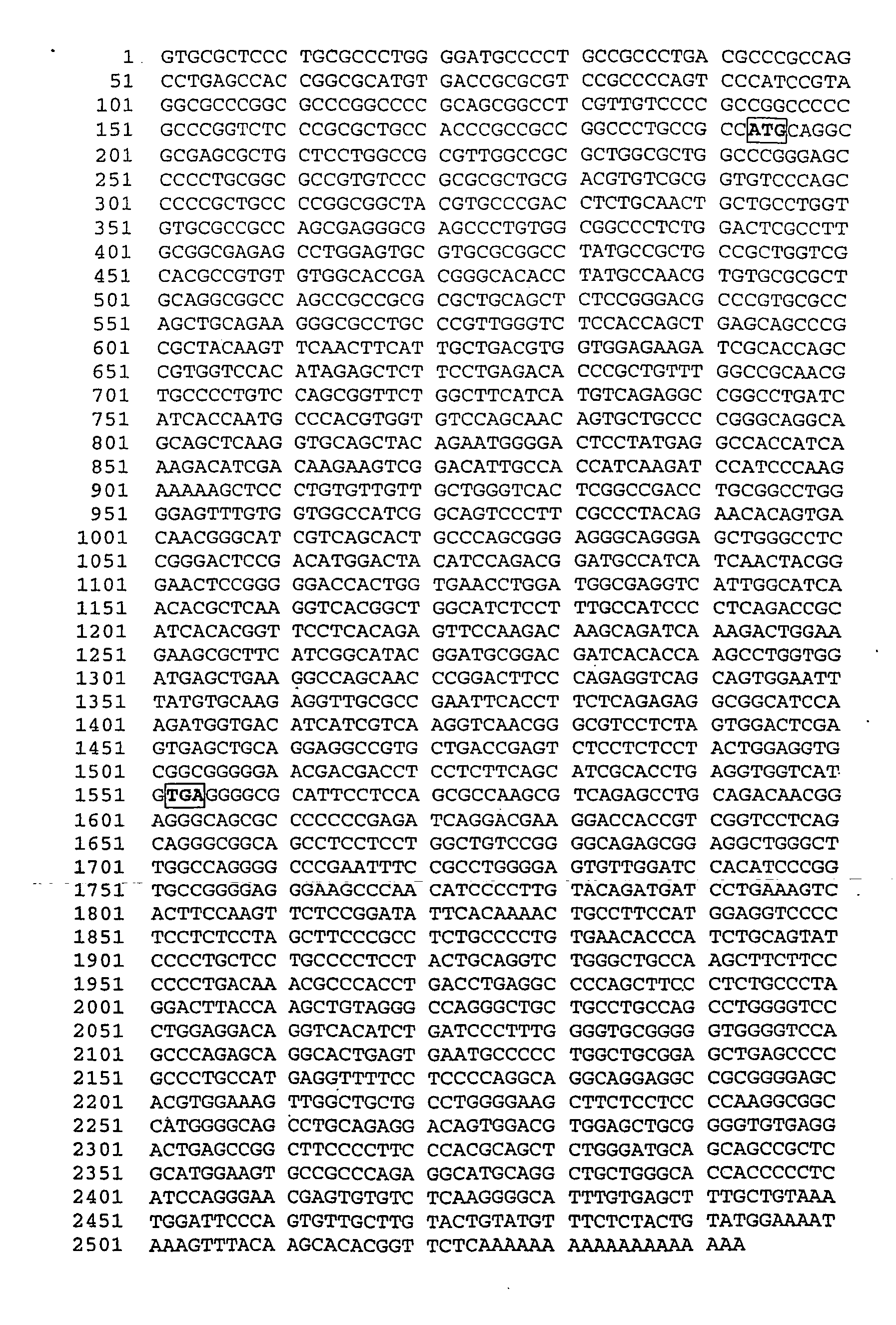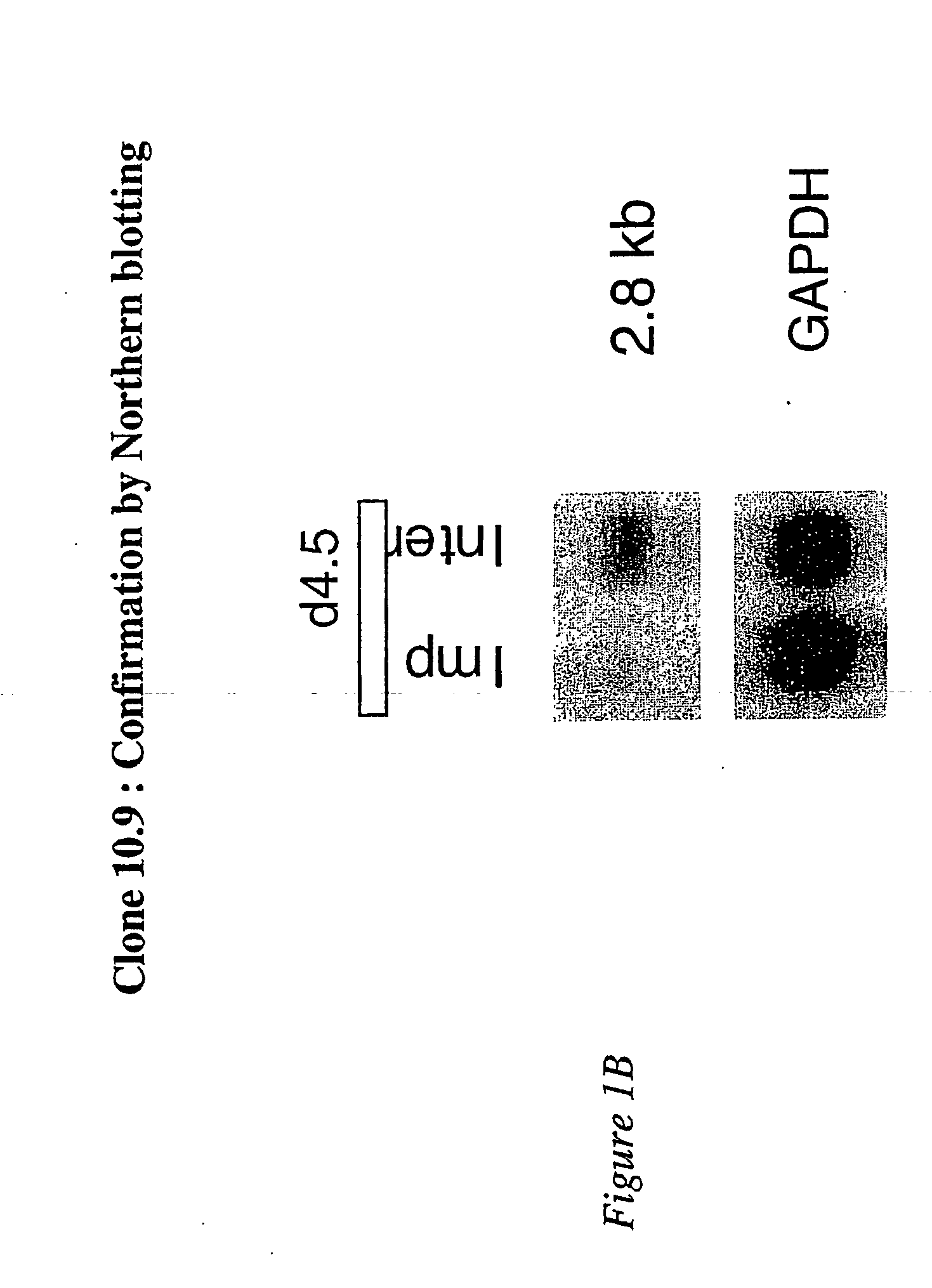Novel serine protease
a serine protease and serine technology, applied in the direction of hormone receptors, growth factors/regulators, botany apparatus and processes, etc., can solve the problem that many other molecules critical for implantation are still unidentified
- Summary
- Abstract
- Description
- Claims
- Application Information
AI Technical Summary
Benefits of technology
Problems solved by technology
Method used
Image
Examples
example 1
DDPCR Analysis and Identification of Clone 10.9 by Northern Blotting
[0201] To identify genes which are potentially critical for the initial process of embryo implantation in the mouse, we compared the uterine gene expression pattern of implantation and inter-implantation sites in the mouse uterus on day 4.5 of pregnancy, using the DDPCR technique. A few bands for which the intensities were different between the two sites were detected on DDPCR gels (Nie et al., 2000b). One of these bands, band 10, was fully analysed, and is described herein.
[0202] DDPCR was performed as previously described (Nie et al., 2000b) and was essentially as described originally by Liang and Pardee (1992, 1993). DNA-free RNA from the implantation and interimplantation sites was used as the template for the first-strand cDNA synthesis. The cDNA was then amplified by PCR using one random primer (10 mer) and one oligo-dT anchored primer in the presence of 33P-DATP. The PCR products were subsequently analysed ...
example 2
Sequence Analysis of Clone 10.9
[0206] Band 10 resulted from the DDPCR amplification of day 4.5 interimplantation site mRNA with the following two primers: 5′ primer, TCTGTGCTGG (OPA-14; SEQ ID NO:18) and 3′ primer, T12MG (SEQ ID NO:3), whose sequences are set out in Table 2 above. After confirming that clone 10.9 contained the cDNA representing band 10, the nucleotide sequence of this clone was determined, and is set out in SEQ ID NO:25.
TABLE 3The sequence of clone 10.9 (359 bp) derived from band 10 ofDDPCR gel1TCTGTGCTGGCCAGGATGGACAGGAAGATGAGTTTCATAATCACATGGTC(SEQ ID NO: 25)51TCCAACCCTGACAGCTCATTCTCCCAAGGTGACTACACGGTGGCCAAAGA101GGAGCGGACACCTGCCTGAGGTGCAAGGACTGAGCCACTTCACCTCTGCA151TGCAGTTCTGGGTGCGGCAGCTGTCTATGAAGATGGCGCCACCCAGCAGC201CAGCAGGCTCCCAAGGGCATCTTTGTTCTCCCTAGTGTTTCAAGTGTATT251TGTGAGCATTGCTGTAAAGTTTCTCCCACTACCCACATTGCTTGTACTGT301ATGTTTCTCTACTGTATGGCATTAAAGTTTACAAGCACATAGCTGCCAAA351AAAAAAAAA
(The underlined nucleotides represent the primers used during DDPCR amplification) ...
example 3
Cloning of the Full Length cDNA Sequence
[0215] In order to obtain the full length cDNA sequence represented by clone 10.9, a mouse uterine cDNA library (Clontech, Palo Alto, Calif.) was screened using radiolabelled clone 10.9 cDNA as a probe; this was prepared as described above for Northern analysis, using the standard method (Sambrook et al., 1989).
[0216] Three clones were obtained; all of these appeared to lack the start codon, so 5′ RACE was used in order to obtain the 5′ end sequence. To obtain the full length cDNA sequence and to search for possible isoforms, standard 5′ and 3′ rapid amplification of cDNA ends (RACE) was also performed, using the 5′ / 3′ RACE kit (Roche, Castle Hill, NSW, Australia).
[0217] The longest sequence obtained from these approaches contained 2450 nucleotides, and is shown in FIG. 2 and SEQ ID NO:26. This sequence included an open reading frame of 1377 bp, with the start codon ATG being at nucleotide (nt) 127-129 and the stop codon TGA at nt 1504-1506...
PUM
| Property | Measurement | Unit |
|---|---|---|
| Fraction | aaaaa | aaaaa |
| Fraction | aaaaa | aaaaa |
| Pharmaceutically acceptable | aaaaa | aaaaa |
Abstract
Description
Claims
Application Information
 Login to View More
Login to View More - R&D
- Intellectual Property
- Life Sciences
- Materials
- Tech Scout
- Unparalleled Data Quality
- Higher Quality Content
- 60% Fewer Hallucinations
Browse by: Latest US Patents, China's latest patents, Technical Efficacy Thesaurus, Application Domain, Technology Topic, Popular Technical Reports.
© 2025 PatSnap. All rights reserved.Legal|Privacy policy|Modern Slavery Act Transparency Statement|Sitemap|About US| Contact US: help@patsnap.com



